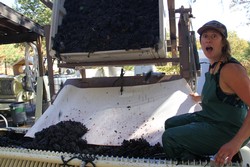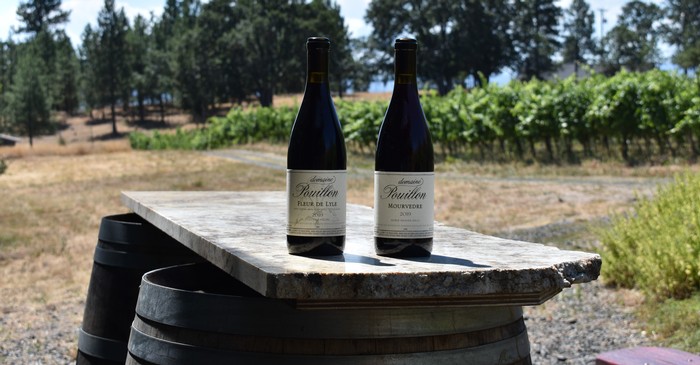Winter in the Organic Vineyard
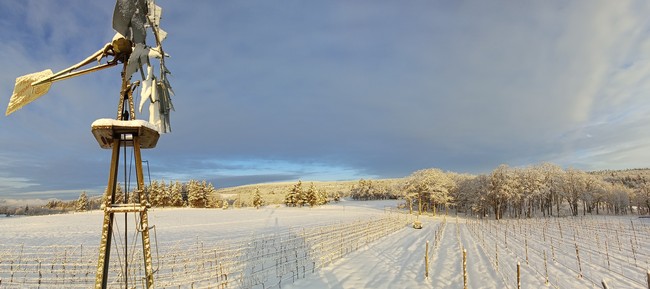
There is a beautiful memoir written by Arlo Crawford called, “A Farm Dies Once a Year.” I often think about that book during the winter. It gives me solace and helps me remember that the deep winter is part of the necessary cycle of the challenging life we’ve chosen. Snow, single-digit temperatures, and freezing rain have shut us into a weather-imposed lockdown. From our cozy chairs, we can watch the bird frenzy at the feeder. The pine trees hang heavy with a ½” coating of ice as squirrels steal mouthfuls of chicken food to take back home. They skitter across the ice with cheeks full of corn. A family of deer seems to have taken up residence under the roof of the seating area outside the tasting room. At night, the deer raid the food left behind by the sheep. Eagles perch on the tops of trees, creating a cascade of ice and broken branches as they take flight, in search of an unwitting rabbit. The resilience of our wildlife always amazes me. It’s in my nature to get caught up in weather hysteria, checking my weather app 5 or 6 times a day. And yet, there is a whole world outside our warm house that needs our attention. So we suit up, check the thermometer, and head out. The driveway needs to be plowed, chickens (and squirrels) fed, sheep (and deer) fed, and ice broken on water troughs. The wine work is done for now. Alexis and Teddi have tended the incredible harvest we brought in, proudly sampling barrels and planning final compositions. The wines sleep the winter away, awaiting the spring bottling. The vines rest dormant under a sheet of ice and snow, as the nutrients from the canopy feed their extensive root system – strengthening the plants for next spring. A deep freeze like this one is helpful to our organic vineyard. There aren’t many insect pests that will be able to survive. With the pest population naturally diminished, the vines will be able to grow without the pressures of thrips, hornets, flies, and grasshoppers. In my mind, I can see the fat buds in the vineyard: downy, green, and pink. I can hear the wind whistle through the trellises. I can smell the earth warming in the sun. Spring always feels like a miracle to me, and I miss it most in the winter.
Wherever you are and no matter the weather outside, we hope you’ve gathered with friends and family to share love and light. Thank you for believing in what we do and for loving the wine we make. Sharing the life we have - our small vineyard, our wines, this incredible chunk of earth – it fuels our passions and gives us purpose.
Be well – Juliet P.
A Harvest Yearbook
When you live by the weather every harvest feels unique. Each harvest starts at a different time, has its own challenges and rewards. We can tell you a story about each year and how this changed the wines and changed us… but we can’t predict how this year will go!
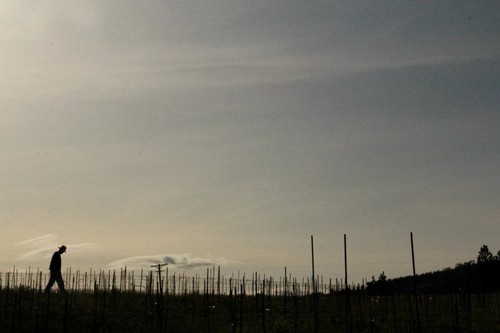
2005 – Our first crush! With purchased grapes and borrowed equipment, we pressed viognier until the press fell apart and finished the job by pounding the grapes with a sledgehammer. Exhausted and in love, we quit our days jobs. Our friends at nearby wineries shared their equipment and helped us finish 2005 strong.
2006 – Able to easily source grapes from Underwood Mountain and Horse Heaven Hills, we enjoy one of the most idyllic fall seasons. The winery is still not built, so we make our 300 cases outdoors.
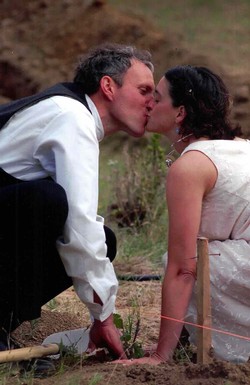 2007 – The winery build begins in March and is finished just in time for our wedding in May. We convince our wedding guests to help us plant the first acre of Syrah in our vineyard before the reception. We kept the vines alive by hand-watering all summer (we don’t recommend this method of irrigation for any crop over a few square feet!) We start selling our wines in the fall and meet our first wine club members: The Harpers!
2007 – The winery build begins in March and is finished just in time for our wedding in May. We convince our wedding guests to help us plant the first acre of Syrah in our vineyard before the reception. We kept the vines alive by hand-watering all summer (we don’t recommend this method of irrigation for any crop over a few square feet!) We start selling our wines in the fall and meet our first wine club members: The Harpers!
2008 – Alexis figures this is the best harvest we’ve had so far. Great weather and perfect fruit help us get up to 2000 cases with the assistance of Sean Davis, who now owns and operates his own award-winning winery in the Willamette Valley: Marshall Davis Cellars!
2009 – The name of the winery official changed from Domaine Pierre Noire to Domaine Pouillon. A very hot and early harvest with a few handfuls of our estate grapes being thrown into the mix.
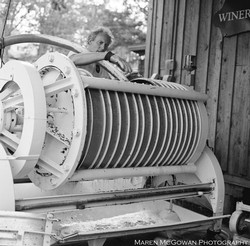
2010 – A cycling angel from the east coast, by the name of John Walsh, crosses the country to help us finish planting and irrigating the vineyard. He stays on for a cool and late harvest. Patience paid off in 2010 with excellent balance and structure in the wines. A wildfire starting on Old Hwy 8 burned all around us in August.
2011 – Brrr. Our coldest year yet! Only one day in 2011 was over 90˚F and this led to underripe fruit that needed extra care in the winery and long cellar aging before release. So late and cold was this harvest that we produced our first (and only) Ice Wine, Saint Lyle du Frigo. 100% viognier frozen on the vines, and oh so good! This year, we were lucky to have a young Brendan Simpers of Willow Wine Cellars help us out on the crush pad. Our first child is born in November, just a couple of weeks before we wrapped up harvest!
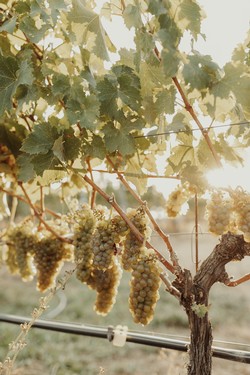
2012 – A ‘Goldilocks’ harvest, and our first real harvest from the estate vineyard. Braced for another cold and difficult harvest, we were pleasantly surprised (and much wiser!) to have perfect fruit in abundance. Plans began to build a new tasting room near the vineyard.
2013 - Now harvesting fruit from our Estate Vineyard, McKinley Springs, Underwood Mountain, Larsen Ranch, McCarthy Vineyard, and Coyote Canyon we experience how the grape harvest can stretch from early September to Thanksgiving. Cameron Larson joins our team and makes a lasting and positive contribution to our wine family. We love you Cameron!
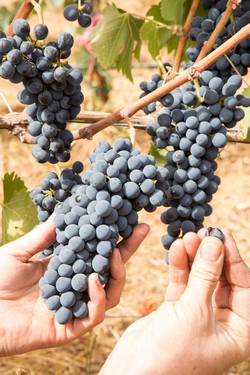
2014 – A superabundant harvest in Washington and Oregon. The quality of the grapes was outstanding, but pushed our small winery to its limits! We finished our new tasting room in February and welcomed our 2nd child in the same week.
2015 – A dry, hot summer led to another great harvest capped off by a hard frost in October. We expanded to other markets, selling wine in DC, MD, NY, and VA. Kyle Ocean joins our sales team and develops a disc golf course in the vineyard and helps us host an incredible ‘haunted warehouse’ for Halloween.
2016 – Sara’s first harvest! We harvested Syrah for rose around Sept 14th. Unfortunately, this year, Alexis experienced a car accident 2 days before harvest and our focus became helping him heal. Much of the winemaking and fun of the harvest, fell by the wayside. In the end, Alexis is all healed up and we had lots of wine to sell in our cellars!
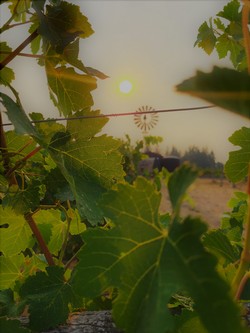 2017 – Family member, Tyler Damato shared his humor and NYC hipster knowledge of natural wines with us. And who could forget that Solar Eclipse? By far the biggest event from 2017 was the Eagle Creek Fire. The fire started over the Labor Day Weekend and high winds carried embers from the inferno nearly ½ mile across the Columbia River. We were very fortunate to not be affected by the fire, but many of our neighbors were – losing crops, homes, and belongings.
2017 – Family member, Tyler Damato shared his humor and NYC hipster knowledge of natural wines with us. And who could forget that Solar Eclipse? By far the biggest event from 2017 was the Eagle Creek Fire. The fire started over the Labor Day Weekend and high winds carried embers from the inferno nearly ½ mile across the Columbia River. We were very fortunate to not be affected by the fire, but many of our neighbors were – losing crops, homes, and belongings.
2018 – Teddi joined our team as our Assistant winemaker! Bringing a wealth of knowledge from multiple harvests in different hemispheres, she has elevated our winemaking style. 2018 was a strange weather year, with lots of cold temperatures in June and hard rains starting in October – making for an extreme rush to get all the fruit picked before it was washed out.
2019 – Heavy snowfall and late bud break. Summer temperatures were cooler than in previous years, with a notable lack of heat spikes. Rains began early in September and forced us to pick early. Tomas Sinor from Sinor-LaVallee Winery joined us with his youthful demeanor and strong back – two qualities we prize very highly around here!
2020 – Ahh… 2020. The year we all remember! In case you weren’t in the PNW for the summer and fall conflagrations: heart-breaking fires raged all around us causing devastation and some of the worst air quality in the world from 9/11-9/14 with particulates getting up to 687. Smoke damage caused crop loss in all our grapes except the pinot we use to make Pet-Nat. At least we had something to drink during the lockdown and quarantine.
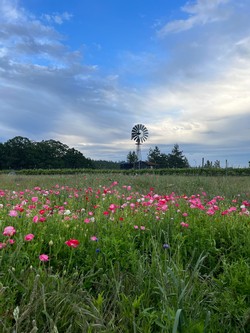
2021 – Remember the record-breaking heat dome that started in May? Our peak temp in the vineyard was 122˚F. Despite that, acids held up well and the weather cooled down in September and October allowing for longer hang time than expected. Alexis and Teddi continue to make excellent wine and their skills brought in 2 platinum and 1 gold medals!
2022 – An extended wet and cool spring with April snowfall of about 9” means the vineyard is three weeks late in ripening. Considering the inconsistency in weather from year to year, it’s impossible to predict if that will translate into a good or bad harvest. As always, we keep our fingers crossed and our eyes on the grapes. The saying goes, “The best fertilizer is the farmer’s shadow on the soil.”
What is the value of being a part of a wine club?
What is the value of being a part of a wine club? For starters, it is much more than just receiving wine twice a year. To us, our wine club members are the foundation on which we thrive. They keep us going year after year, financially and emotionally.

Twice a year we get really busy preparing our club shipments. Every spring and fall we offer 6 bottles of wine to our club members. When you are part of our wine club, you of course get perks and discounts that others do not. This includes a 20% discount across the board, on wine, merchandise, and ticket purchases for example. Free tastings for you and a guest… although this is common with wine clubs, this really is a huge benefit because you get to keep coming back, experiencing our vineyard and wines as we cycle through them season after season, year after year. One of the things we are proud to offer in the Grand Cru is the ability to customize your allocation, both with substitutions and additions, so you will never be stuck with a wine that isn’t perfectly up your alley! Although, if indecisiveness is a thing for you, we make it easy by choosing the newest, greatest vintages that we offer.
On occasion, wine club members get access to wines that are club exclusive. This past spring, we had two bottles that this applied to, our Estate Syrah 2018, and our Pinot Noir 2019. There are times when we are only able to produce so many cases of a certain wine, so rather than making it available to everyone, we only allow access to our members. Another great perk is the ability to attend events that are only available to our club members. Covid-19 really threw a wrench in the in-person events that we used to have, which although necessary, didn’t make it any less devastating. Now two years later, we are opening up more and more, bringing back old events and even trying out new things.
For this fall club release, we are having a new event called Farm Days. Rather than the traditional club party where we have food and music (which is great), this time we wanted to extend a tour of our whole operation to our club members. Come tour the vineyard with owner and winemaker, Alexis Pouillon, and learn about terroir while tasing our club wines. Taste locally sourced food pairings from Chef Juliet Pouillon and tour the winery with Assistant winemaker Teddi Fuller. This fall we have 2 different reds that we are very proud of. A single varietal Mourvedre and Fleur de Lyle, our Cabernet Sauvignon and Syrah blend. Both are from 2019, an exciting vintage for these varietals. The summer of 2019 was notably cooler and considerably more even than in recent years. We picked early as frost and rain approached in early October. These somewhat cooler temperatures contributed to lower overall sugar accumulation and higher acidity which makes the Mourvedre just shine and the Fleur de Lyle a bit more restrained than in previous years.
The time, love, and energy that goes into making wine is extensive. It is a process that takes years, from when spring comes and the vines come back to life, as the grapes grow in size over the summer, to Harvest time when the grapes are picked and crushed, as they age and ferment over time, to eventually getting bottled and then later released for all to enjoy. When you become a club member, you support us in this long, but joyous work. We love our club members and could not do this without them.
-The Domaine Pouillon Family
Coeur of Discovery - French Master Chef Benefit Dinner
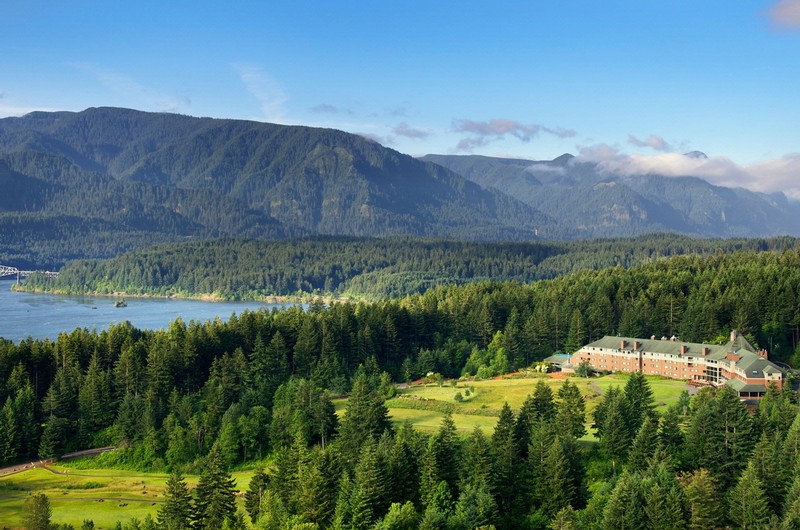
On February 25th, our winemaker Alexis Pouillon and our wine club manager Sara Dyberg were able to attend and be a part of an amazing event at the Skamania Lodge in Stevenson, WA, called the “Coeur of Discovery”. The event was a French Master Chef Benefit Dinner consisting of a six-course meal, wine from multiple Oregon & Washington wineries, and one great cause at the heart of it all. Imagine a French Master Chef on the Lewis and Clark expedition, also called the “Corps of Discovery”, in awe of the bounty of food and wine offerings provided by the Northwest. The abundant discoveries culminated in a French-inspired evening of six courses that included the most delectable items from the region.
100% of the ticket sales were donated to the Blanchet House, a nonprofit organization in Portland providing meals, clothing, and life-saving shelter programs to people in need. The Blanchet House serves 3 meals per day, 6 days per week to anyone who is hungry. Their mission is to alleviate suffering and give hope for a better life. Something Domaine Pouillon is always happy to be a part of is giving back to causes and charities that we support.
As part of our involvement, we brought six different wines to pair with the dinner: our 2018 Katydid, 2019 Pet-Nat, 2019 Blanc Du Moulin, 2018 Pinot Noir, 2018 Riesling, and our 2019 New Normal. Some standouts from the menu were the black cod with crispy pork belly and lemongrass oyster bouillon, as well as a wine poached forelle pear dessert with an almond financier crumble and sea salt mousseline. The four Master chefs involved in the event were Olivier Gaupin, Phillippe Boulot, Eric Truglas, and Skamania’s own Zac Janssen. According to Sara, she said the event felt very jubilant, and everyone was thrilled to be participating in an event that had 100% of the ticket sales being donated.


The Columbia River Gorge is a special place, one that we feel very lucky to call home. The Gorge has a rich history, particularly that of Lewis & Clark and the Oregon Trail, but also the thousands of years of Native American history. Being invited to participate in a local event that paid homage to this history felt incredible. We want to thank Skamania Lodge for inviting us to the Coeur of Discovery dinner and we hope to collaborate more in the future.
Do's and Don'ts of working a harvest
What's it like to work a harvest
Harvest time is here! There's an excitement in the air as all of the hard work in the vineyard culminates to the epic conclusion: picking the grapes and turning it into wine!
This will be my fourth harvest across three continents, and I wanted to share some helpful tips. Whether you have a harvest position lined up or just curious, read below to get the scoop.
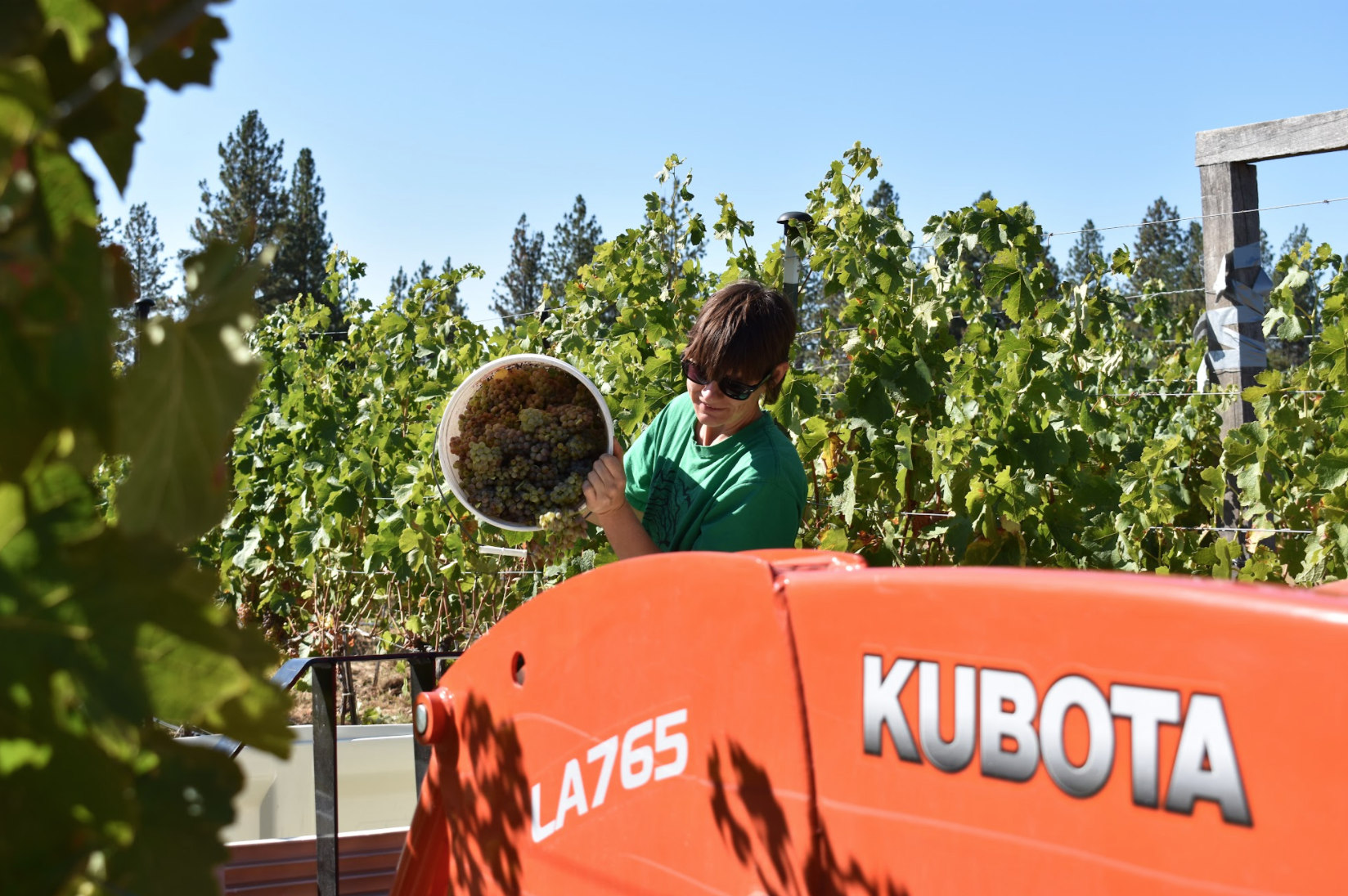
Do's and Don'ts
DO expect to work a lot.
Most of the year with winemaking and viticulture, hours can be estimated and scheduled fairly easily. All of this goes out the door during harvest. Expect long days and sometimes evenings well past dinner time. Harvest is a lot of hard work, but extremely rewarding if you're passionate about wine.
DO expect to learn.
One of the best reasons to get a harvest internship is to learn from winemaking professionals. Learn by doing is one of the most effective ways to absorb information. Employers realize this, and so they will be happy to answer questions during harvest (as long as the Q&A doesn't interfere with work). Winemaking courses at UC Davis were very interesting and packed with information; but nothing compares to the hands-on experience.
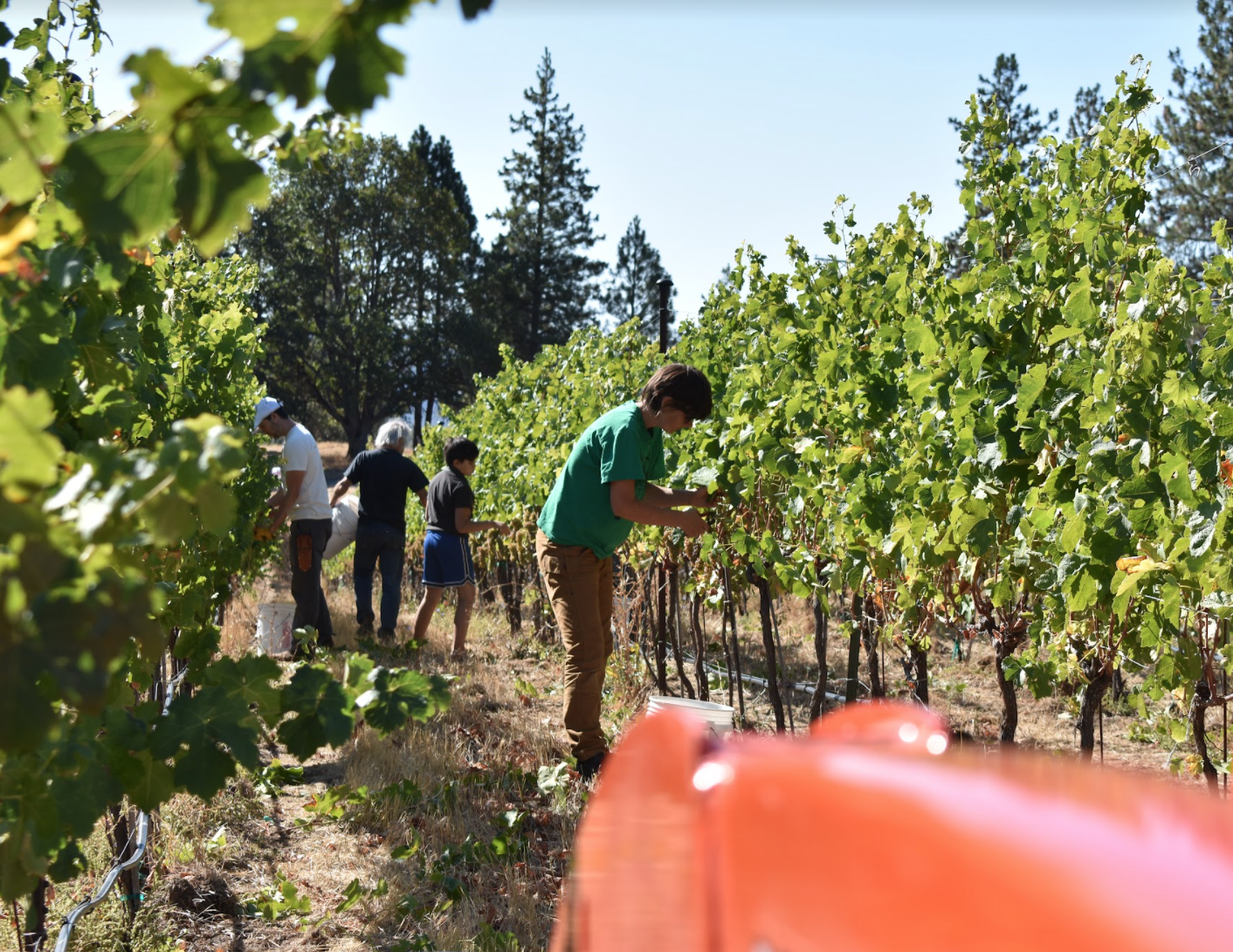
DON'T be afraid to ask for help
Time is valuable as there are only so many hours in the day. There is a lot to be done: cutting fruit from vine, sorting, pressing, cleaning, racking, running brix/temperature numbers, additions, punchdowns, pumpovers, cold soaks, cleaning again. Things move at a very fast pace and It can be overwhelming; especially if it's your first time. That said, most everyone we've met in the industry is gracious and willing to help. So if you don't understand something, speak up!
DO volunteer to cut
Most wineries will have crews hired for hand-harvesting, or will machine harvest. It may seem like picking fruit is a laborious, mindless task. However, we strongly recommend participating as it will give a new appreciation for the hard work that picking crews do and also a front row seat at the most important moment in a grape's journey to become wine.
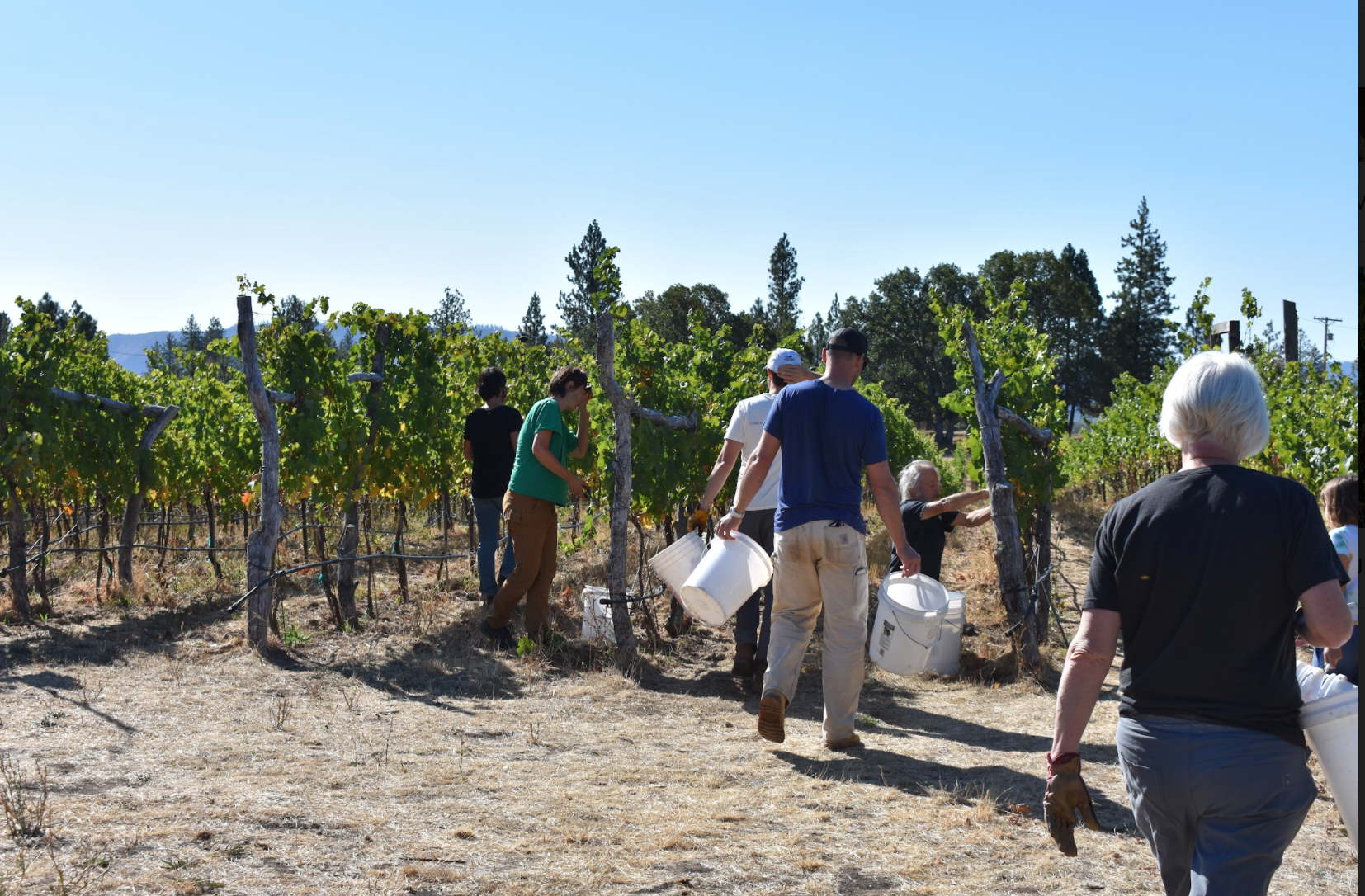
Don't complain
No one likes a complainer. This is amplified during high periods of stress. Even if it means cleaning a tank for the x-teenth time that day, be prepared to get your hands dirty. No task is too low on the totem pole, even for the head winemaker. There are a lot of unglamorous things about winemaking; but if you truly love what you are doing, it won't matter.
DO stretch
Bending over to pick fruit, heaving heavy hoses above the head, pushing and pulling large equipment, punching down fruit caps -- it's a big strain on the body. Your back, shoulders, arms and legs will all be put to the test. Thus, make sure you are stretching daily to avoid unnecessary injury.
DO have fun
Harvest is not for the faint of heart. It is HARD work. It's likely the hardest you'll ever work, but also the happiest you'll ever be. At least it was that way for us! Never forget why you decided to work this role; perhaps it was to actualize a dream in winemaking or for a new life experience. Regardless, enjoy the ride and have fun!
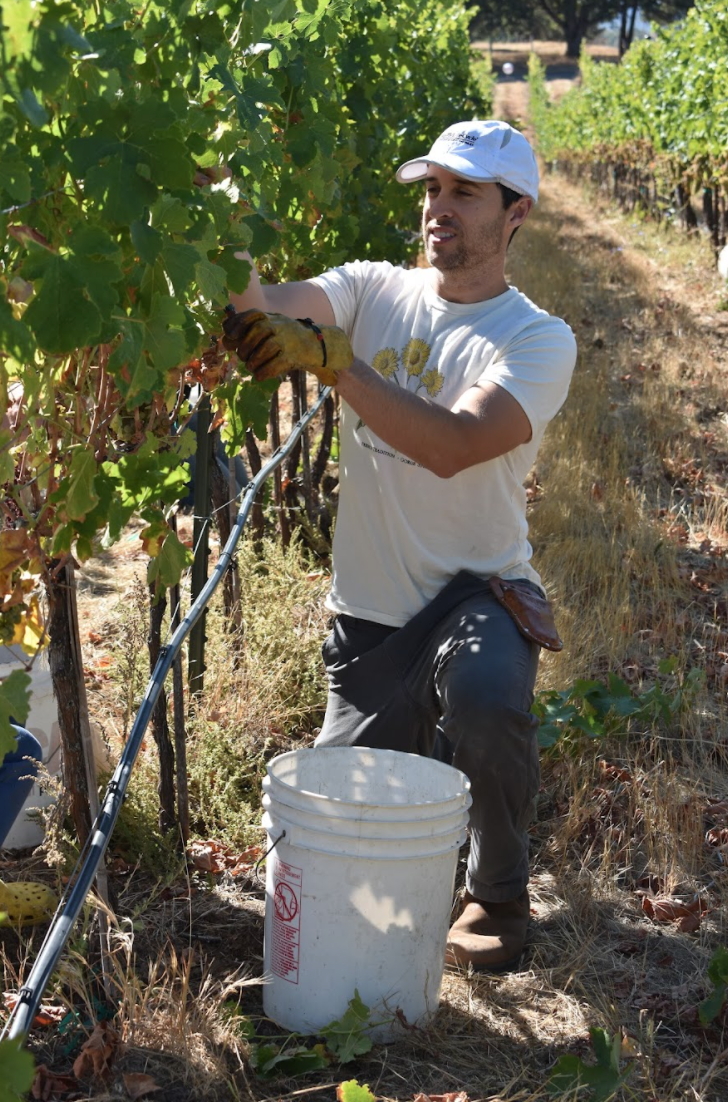
How I came to work at Domaine Pouillon
Life has a funny way of coming full circle. The ebbs and flows of life and where it takes you can be the most wonderful of surprises. Here is my story and the story of how I came to work at Domaine Pouillon, the family winery you all know and love.
My name is Sierra; I grew up in White Salmon, WA, after spending the first 5 years of my life living in various other states. White Salmon, which is in the Columbia River Gorge (same as Domaine Pouillon), drew my family in because that’s where our family was from, at least my dad’s side of the family. The Larsen family settled in White Salmon in the 1890s after immigrating from Norway, upon receiving land from the Homestead Act. The act required that recipients had to “improve” the plot by building a dwelling and cultivating the land. As time progressed and after they completed the large barn structure, they set off to complete their 4-story farmhouse and begin their long lives on the land that was theirs.
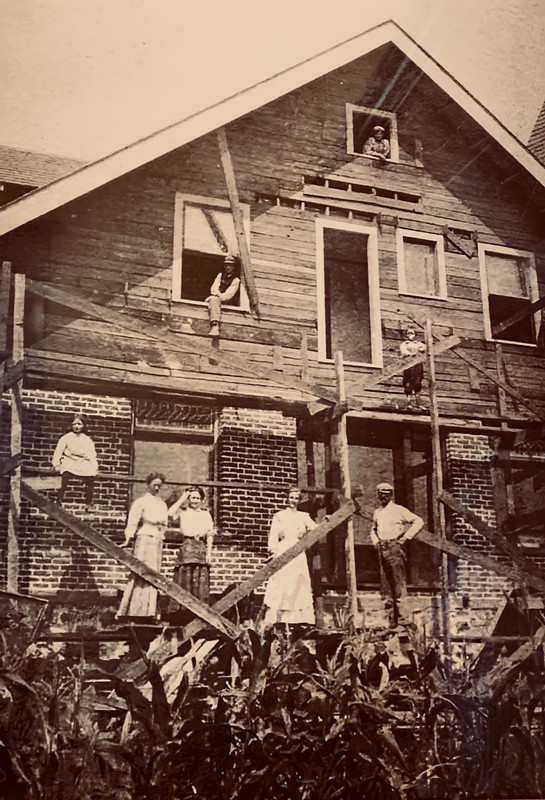
For generations, my family has lived in this home, passed down from son to son in the 1900s. I was lucky enough to live there many years myself with my parents and brother when I was a kid. I feel so lucky that back before the internet and cells phones took over, I had a childhood filled with outdoor exploration, riding bikes up and down the long private drive, making leaf forts in the fall, sledding down the hills in the winter, and climbing the cherry trees in the summer in search of a delicious, dark cherry. Overall, “The Farm” as we call it, became known as a cherry orchard, which my grandfather Don ‘Donny Guy’ Larsen ran for many years.

Around the year 2000, my family tore out a lot of the cherry trees that had been there for decades and started to incorporate grapes into the land. They ended up calling it Jewett Creek Vineyard; named for the creek that runs through the property. Even though I moved away for high school, and eventually on to college, and so on, The Farm was and always has been home. I have many fond memories of spending holidays up there, staring out at the beautiful view of Mt. Hood and watching the vines and cherry trees change color during the various seasons.
I met Alexis and Juliet probably around 2010, somewhere in there. At this point, the two of them had started a business relationship with my grandpa Don and my aunt and uncle, who now own and reside at the property. Domaine Pouillon gets their Pinot Noir, Chardonnay, and Pinot Gris grapes from Larsen Vineyards, as it's now called, as well as Gewurztraminer once upon a time. I remember the first time I drank wine that was produced with my family’s grapes; I was right around the age where I was legal to drink and was also getting excited about the idea of becoming a “wino.” I felt so proud and thrilled to taste something that was grown on the very same property that I grew up on, in a place where my great-great-grandfather had come to and started a family.
One particularly fond memory I have was when I was living in Seattle in 2013 and working at a local grocery store called The Ballard Market. I had just found out that our store started to carry Domaine Pouillon’s Gewurztraminer, which was made with 100% of my family’s grapes. I ran over to the wine department, found the bottle, brought it up to the floral department where I was working, and started snapping pictures. I left a bottle up there as a selling tool as well. I’d say, “If you like wine, I highly recommend this bottle. It comes from this great family-owned winery near where I grew up and the grapes actually come from my family’s vineyard.” I was beaming because even though I knew I had nothing to do with the winemaking or growing process, I was still so proud to show off my family’s stuff, and Alexis & Juliet’s wines.

That was a day not too long before my departure from Seattle and The Ballard Market. In October 2013, I took off on a three-month solo trip to Europe, which was the adventure of a lifetime. A highlight of that trip was sipping wine in the various cities I visited, like Paris and Madrid, but especially all-around Italy. I lost my cell phone halfway through the trip, which I was devastated by at the time, but in the years since I have always been grateful for that. I was very present in each moment, letting myself experience the adventure with all my senses. Florence was amazing, I could have stayed forever, but shortly after I stayed and worked at a winery in Tuscany for over a week called Il Bacio “The Kiss,” and it stole my heart. 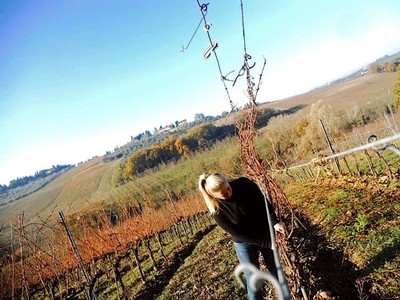 Waking up to the early morning Tuscan light, pruning while the morning chill and fog wore off, then watching the sky open to reveal golden fields and rows of cypress trees was just such a treat. Of course, I can’t forget returning to the house when I heard, “Mangiare, mangiare,” to enjoy lunches and dinners with the family who owned and operated the place. The food, wine, and conversations were so special, it almost feels like it never really happened. Perhaps I dreamt the whole thing…
Waking up to the early morning Tuscan light, pruning while the morning chill and fog wore off, then watching the sky open to reveal golden fields and rows of cypress trees was just such a treat. Of course, I can’t forget returning to the house when I heard, “Mangiare, mangiare,” to enjoy lunches and dinners with the family who owned and operated the place. The food, wine, and conversations were so special, it almost feels like it never really happened. Perhaps I dreamt the whole thing…
I did not realize at the time that one day I would change career paths and come to work at another family winery, but not for another 8 years!
Once I returned to the US, I ended up relocating to Arizona, where I even worked at a wine bar for a time, before eventually moving to SoCal 7 months later. In California, it felt like anything was possible. Any dream of mine could be fulfilled there, even far-off Hollywood dreams from when I was a kid. Ultimately, after a few years spent there, I really started to miss home. It took me traveling the world, moving away to different states and climates to realize in my heart that home for me was and will always be the PNW. California was of course beautiful and thrilling, but after a while, the lack of rain, lush forests, and mountains really got to me. I also missed my friends and my family.
At this time, in 2016, I had a decision to make on whether I was to move back to Seattle, to Portland, or back home to White Salmon. Something drew me back to Seattle, so I followed my heart and returned to the place I had left 3 years prior. A few months after returning, I ended up finding a job working as a floral sales representative. Later that year, I ran into a guy I knew from years and years ago and ended up wonderfully hitting it off. Long story short, after a few years we got engaged and soon thereafter moved to Portland, OR together and was able to transfer with my job. As we were planning our wedding, set for October 2020, we like everyone else in the world had to deal and adjust to life during a pandemic. I admittedly drank lots of wine during this timeframe, coping with the stress of it all, all while trying to plan my dream wedding. Just before getting married, we had been searching for somewhere in the Gorge where we could move to and settle down. Finally, the perfect house popped up, thirty minutes away from where I grew up. Everything felt like it was falling into place, even with the stress of the pandemic.
We got married on October 10th, on my family’s vineyard and orchard, the place I had always dreamed of getting married at. Despite Covid and some rain, it was a beautiful day spent with our closest friends and family. As the months passed, and as I was getting more and more used to being married and having our own home in a small town again, I started to feel like it was time to move on from my job and “The Big City”. I had now worked there for four years, and a lot had changed and happened to me during this time. I just felt like I outgrew it and that bigger, better things were on the horizon. When my aunt told me about the opening at Domaine Pouillon, it felt like something clicked. It was intimidating, sure, to leave a large company with all the bells and whistles for a small, family-owned business, especially during the times of Covid. However, the thing that “sold” me was how they take care of their employees and the general values they stand for. It was hard to not feel like “just a number,” at a corporate job. At Domaine Pouillon, it is literally a family, and everyone has each other’s backs, and everyone here contributes to the overall success of the winery. I could have real lasting change and impact here. Many perks existed, such as it was in the Gorge and not Portland, so I could feel like a part of the community I grew up in again. It was a winery, with a beautiful vineyard and idyllic views from every angle. I left fluorescent lights for natural lighting, mixed in with the sound of nature and the wind.
I think back to years ago when I would see Alexis, Juliet, and the kids in Seattle, when they were up there for business and staying at my aunt’s home, where I also lived in the basement apartment. Sometimes I would even watch the kids for a bit while they had dinner or business to attend to. It’s been a fun experience to see the kids grow and change, especially now that I see them nearly every day.
Serendipity is my favorite word, mainly because it’s so easy to get caught up in the struggles and hardships of life, especially these days, but when we stop and admire the serendipitous moments in our life, then the real magic can happen. As I reflect on my life, it really does feel like a full-circle moment for me to be working here. How serendipitous was it that they had an opening just at the same time I was thinking of working elsewhere?
Domaine Pouillon’s values are Community, Stewardship, and Family. They care for the community that they are a part of, and they give back when possible because they want to make a difference. They treasure the land that they live and work on and that love, and commitment are translated in the amazing wines they produce. Family is very important to them, perhaps above all else. Their family of course, but also the family that is made up of their staff and customers. Since I’ve come to work here, I feel like a weight has been lifted off my shoulders. They know that work is important, of course, but also that there is much more to life than working. The balance and the culture that is to be found here are exciting and calming all at the same time. I’m excited for all that is to come.
I’m thankful that Alexis, Juliet, Gigi, JP, and all of the staff here have welcomed me into this Domaine Pouillon family. Cheers to good wine, good people, and a good day’s work.
All about Canopy Mangement
In the last post, I described the many vineyard tasks in the Spring such as pruning, tying and trellising. As the vines start to grow and the long summer days kick in, Alexis has stressed the importance of the next task at hand: Canopy Managment. This is what I've learned so far:
Canopy definition
The canopy of a grapevine is defined as the collective parts of the grapevine's fruit, trunk, shoots, cordons and leaves. So technically, when we covered pruning and tying down canes, that was canopy management too--albeit early stages.
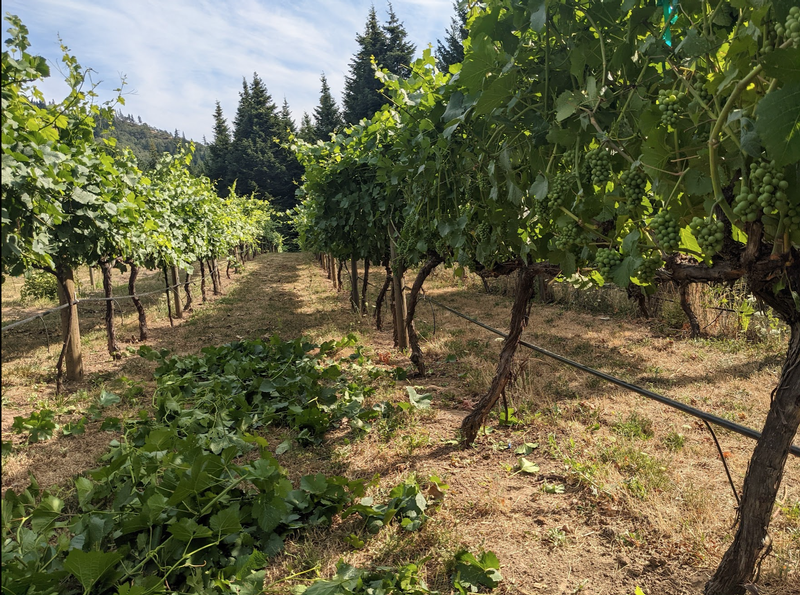
The real guts of the actual managing of the canopy happen once the vine starts to grow--shoots, leaves, suckers, fruit everywhere!
Purpose of canopy mangement
The goal of managing the vineyard canopy is to bring forth the best possible grapes to be grown. During the summer, the grapes undergo a critical growth phase in their life--the build up before harvest in the fall.
Left to their own will, vines will grow all over the place; into the rows, over the trellising wire, hang to the ground, shade the fruit etc.. but there are things one can do to improve the quality of the fruit.
How to effectively manage the canopy
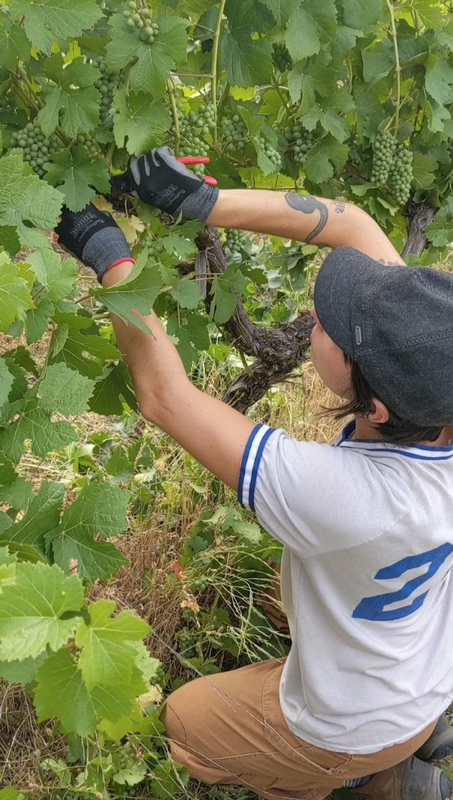
Follow these tips for effective canopy management. Style will differ with every vigneron, but this is what we've observed and learned so far:
- Generate airflow: Airflow through the vine's canopy is key. It will reduce the amount of disease pressure like mildew and bunch rot, requiring less spraying.
- Tucking: this may vary depending on the training and trellising style, but for VSP (vertical shoot positioning), you want the vine's shoots to grow upwards. In order to influence the vine to do so, you'll need to tuck the wild shoots into the trellising wire. This will not only help with airflow, but also allow more sunlight to reach the leaves for photosynthesis.
- Thinning: Too much fruit actually may not be a good thing. Balance is key in the vineyard and the vine's limited energy is stretched too thin by too many clusters on the vine, the end result won't be favorable. So the remedy is to thin (also known as dropping fruit). Another aspect of thinning is to get rid of any suckers and water shoots that didn't bloom any fruit.
- Leafing: Similar to abundant fruit, too many leaves can be a problem as well. Leaves are important to the life of the vine as they receive energy via photosynthesis. However, too much can block airlfow leading to higher disease pressure and provide too much shading to the fruit and
- Exposing the fruiting zone: Grapes need sunlight to ripen. If they are covered in shade by leaves, they're going to have a bad time. Thus, getting rid of the leaves in the fruiting zone will enable the grapes to have more sunlight exposure, help with airflow and also allow for anti-mildew spray to reach the grapes more easily.
- Deer Decoy: If the vineyard is not fenced properly, it may fall under attack from free roaming deer. Deer don't necessarily eat the fruit but they will munch on the leaves. By keeping a few leaves around the fruiting zone, it will allow some margin for the deer to consume their leaves without negatively impacting the plant.
Key takeaways for Canopy Management
Domaine Pouillon stresses balance in the vineyard. Too much thinning and leafing will lead to a malnourished vine. In contrast, a vine that has too many fruit clusters and leaves will have a tough time reaching full ripening and maturation.
There are many choices to make during this critical phase. Choose wisely, and the vine will be set up for success as we barrel toward veraison and harvest.
First four months working at the winery
What’s it like to work on a winery?
My exposure to winemaking thus far has only been helping out during harvest. Long, enjoyable hours of carefully moving fruit and juice from one area to another. Cleaning, laughing, drinking, cleaning. The work was fast paced and often left me with more questions than answers. I had a focused snapshot of the winemaking process, but not the entire picture.
Working at Domaine Pouillon has allowed me to see the entire process–from pruning to vines breaking buds and eventually, to harvesting and fermenting. Here are some of the highlights from working at the winery from January to May, 2021:
Great wine begins in the vineyard
This is an old saying.. and one I had rolled my eyes at.. just a marketing term right? But now I appreciate how much work goes into the vineyard–basically all year, until the fruit is ready to be plucked. The healthier the fruit is, the easier it will be to transform into wine.
Since harvest is completed by winter, most of my hours have been spent in the vineyard. I was grateful for this, since it’s the area of winemaking that I’ve had the least experience with.
Ripping out vines
Winter vines are dormant, free of shoots, leaves and fruit. Thus, it’s a great time to make decisions about propagating, removing, or planting new vines. In one of the vineyards, we removed a few acres of vines that were malnourished or dead. This was accomplished by securing one end of a metal chain to the base of the vine and the other, to the bucket of a tractor. Then, liftoff!
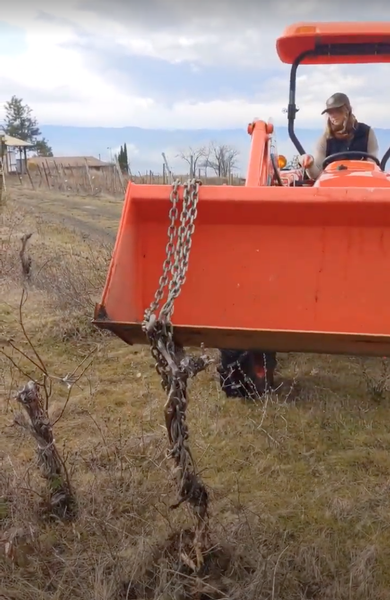
Assistant Winemaker Teddi Fuller operates the tractor to rip out the dead vines.
Once all the vines are out of the ground, then we can mix the area to get the soil breathing nicely. Next, we add organic compost to the ground and eventually, replant with cuttings (young vines) to hopefully produce some beautiful fruit in a few years.
On the estate vineyards, most of the vines are in good shape. However, there are the occasional ones that die or are damaged (frost damage can be one culprit). For the one-off’s, it’s inefficient to use a tractor, so we simply remove by hand and shovel. Sometimes there’s a young shoot from the base (a sucker) that we can re-train to the metal stake. For more on training vines, see below.
Pruning, Training and Tying
Pruning is one of the most important decisions that a vigneron must make throughout the year. Prune too aggressively, and you’ll be left with a meager fruit output. Prune too little and have too much fruit, diluted flavor as well as possible problems stemming from the lack of airflow in the canopy.
Additionally, how the vine is pruned will result in consequences not only this year, but the year after as well. I spent time pruning in Sonoma at Small Vines winery, but other than that I was starting with a blank slate. Alexis (owner of Domaine Pouillon) stressed the importance of balance — leaving the proper amount of buds on each vine and setting up proper spacing to maximize airflow without leaving gaps. Every vine is like a puzzle; where do I cut in order to maximize the chance for best possible grape quality?
Once vines are pruned, they need to be trained. Training vines involves securing the trunk to a post (usually made from metal or bamboo). One project we worked on involved replacing bamboo stakes with metal ones, as metal lasts longer and won’t be subject to corrosion and breaking like bamboo. Vines will naturally have a mind of their own and by training the base to an upright post, you are helping them produce shoots in the desired vertical direction.
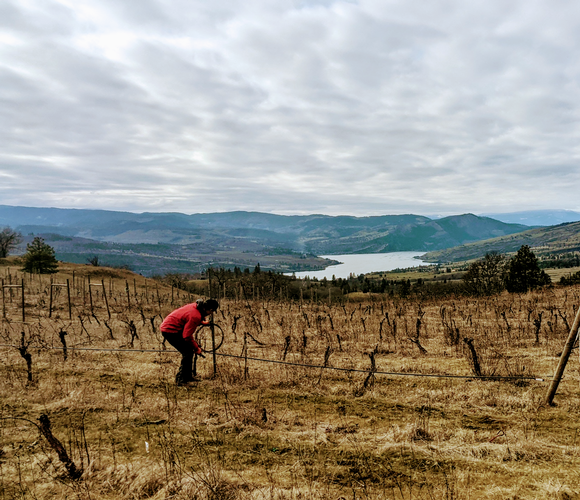
Shoots are the current year’s growth, and what will birth the fruit. Shoots grow from canes, also known as last year’s shoots (cane pruning) or from the cordon trunks (spur pruning). Left unattended, shoots will grow wild, using their tendrils to attach themselves to anything they can. Some vineyard managers and winemakers actually leave vines to grow like this and it’s called Bush Vine — popular in places like Swartland in South Africa.
Assuming you’re not aiming for Bush Vines, then you’ll want to tie the cane or cordon down to the trellising wire. This is done for two reasons: 1) to encourage vertical growth of the shoots and 2) to prevent the arms of the vines from blowing all over in the wind. The Columbia Gorge is extremely windy and when the canes produce their shoots with leaves, the plant will act like a large sail in the wind; tying down the wood to the trellising wire will keep the vine steady in squall-like conditions.
Suckering on the vineyard
After the vines are in a good place for growth, we wait for budbreak. This is exciting to see the transition from dormant wood to new growth for the upcoming season. Hopes are high with these beautiful green beauties spurting out!
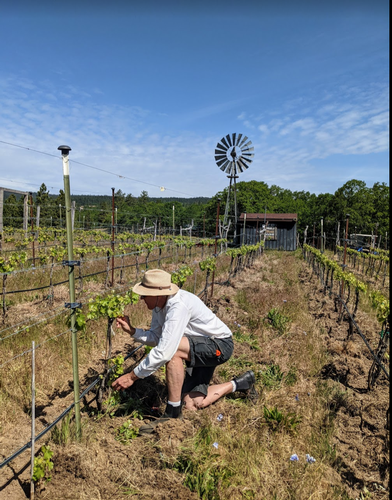
Alexis Pouillon inspects a vine while suckering
However, not all growth is desired. There’s a fixed supply of energy that the plant can produce, so you only want that to be focused in the right areas (up, into the shoots that are spaced properly). Shoots will grow all over the vine — the trunk, the base and parts not intended along the arms; these are called suckers. Suckering is pretty simple — just need to remove them with your hand. This will eliminate unnecessary energy being transferred to undesired locations and instead, focused into the intended areas of the vine.
Takeaways
Compared to storm of working a harvest, the Winter and Spring vineyard work has been a cool breeze; sipping my wine instead of gulping it down. Taking a minute to really understand the process and the amount of labor involved. Learning, learning, learning.
Appreciating the rewarding feeling of working with my hands with the sun at my back. Four months in and I am so happy; confident that I made the right decision to devote my full attention to our dream of winemaking. Often times during the day, I have a feeling–one that I never had while working at a desk–that in this very moment, this is exactly where I want to be and want to be doing.
6 Reasons why the Columbia River Gorge will be a top wine destination
The Columbia River Gorge is different from the Columbia Valley. Quite different in fact from any wine region we’ve ever been to–and we’ve been to them all (mostly).
What makes the Columbia Gorge so unique? We’ve compiled a list.
1. Sheer beauty
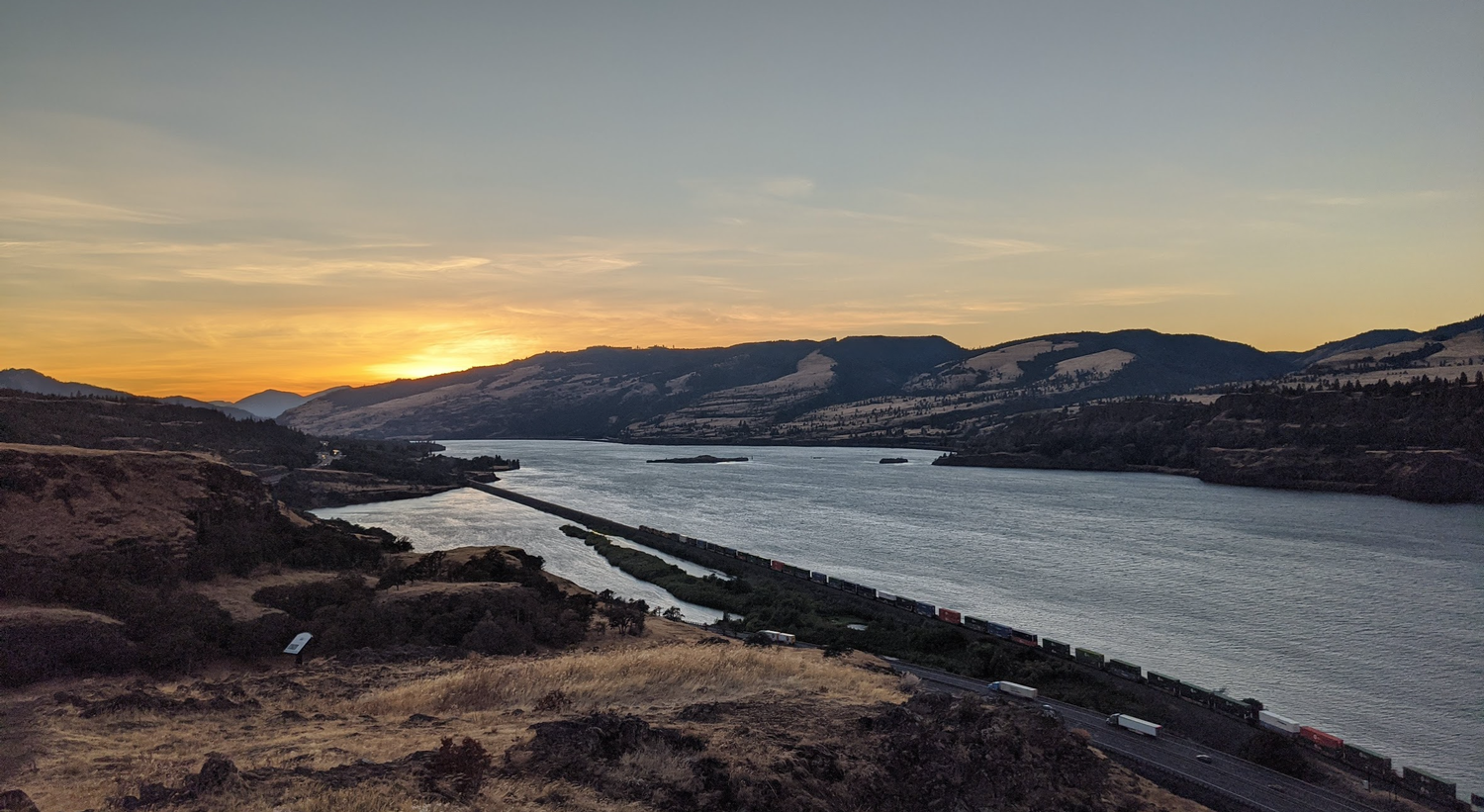
The first thing you’ll notice when driving to the Gorge (most commonly east from Portland), is how strikingly beautiful the approach is. The vast, quick-moving Columbia river flanked by large cliffside mountains, create an appearance of a long, running canyon. Waterfalls line both the Oregon and Washington sides with few noticeable housing structures (thanks to a strict preservation committee).
Many wine regions are beautiful, but often present a similar image of rolling hills, moderate climate and the “zen” of wine country. Few destinations have such eye-popping natural wonders, like Mt. Hood and Mt. Adams complimenting the foreground of waterfalls, rivers and vines.
2. Variety is the spice of life
To characterize the Gorge from a varietal and climate perspective is a difficult task. When people ask us, we usually respond with “well.. it depends”. To the west on the Washington side, you have a cold, rainy climate which barely reaches enough growing days to ripen white varietals and few reds. This region of Underwood is said to be getting its own Sub-AVA soon and is often compared to Burgundy.
As you head east in Washington, things start to warm up and by the time you reach the town of Lyle (about 30 miles east of Underwood), it’s roughly 5-10 degrees hotter with half the average rainfall. Here in Lyle, Domaine Pouillon works primarily with Rhone varietals (Syrah, Viognier etc..).
South of Lyle on the Oregon side is Mosier, where Analemma Wines is producing everything from Grenach to Cabernet to Pinot Noir to Gerwurztraminer. Adding another variable into the mix is the high winds which can create small pockets of microclimates.
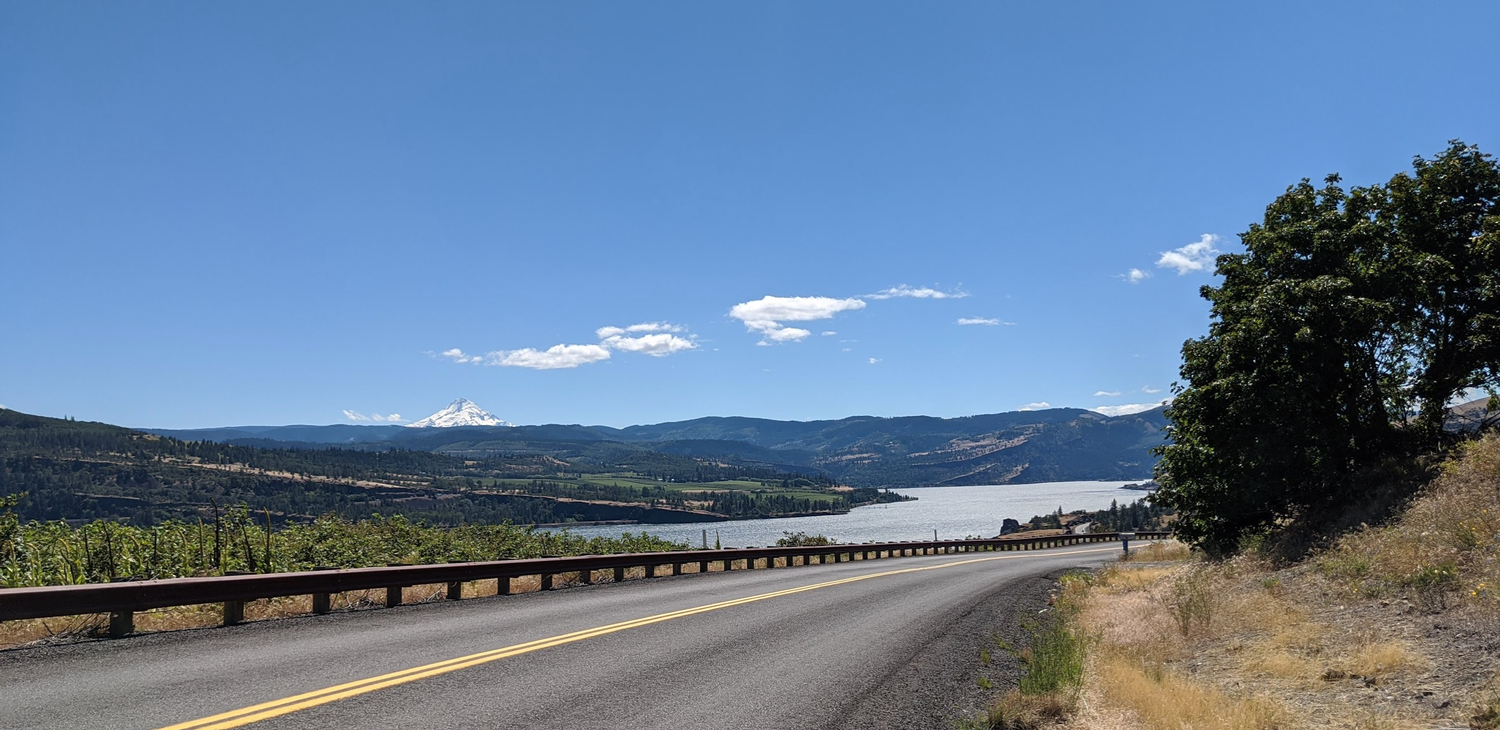
Many regions are typified into one or two i.e. Willamette Valley: Pinot Noir and Pinot Gris, Margaret River: Cabernet and Chardonnay, Burgundy: Pinot Noir and Chardonnay. But in the Gorge, there are virtually endless possibilities.
3. So much room for activities!
We’ll just assume you’re not complete wine nerds like us who will spend a week tasting wine at 20+ wineries (this is not an exaggeration, and here are some tips). Thus, you and/or your party may want to fill the schedule with a few non-wine related activities.
There is no shortage of adventure here: Kite boarding, wind surfing, rock climbing, mountain biking, white-water rafting, horseback riding, sailing, hiking, kayaking, skiing, snowboarding, snowmobiling, snowshoeing.. you name it, it’s here.
4. Less developed than ______
Over the last 50 years, many wine regions around the world have transformed from sleepy farming areas to bustling tourist industries resembling the likes of Disneyland (we’re looking at you, Napa). Crowded wine regions not only make it harder to nab tasting appointments, but naturally drive up the costs ($100+ per person is not uncommon in Napa and Sonoma).
Not in the Gorge. Average tasting fee runs ~$15/flight and bottle prices are very reasonable.
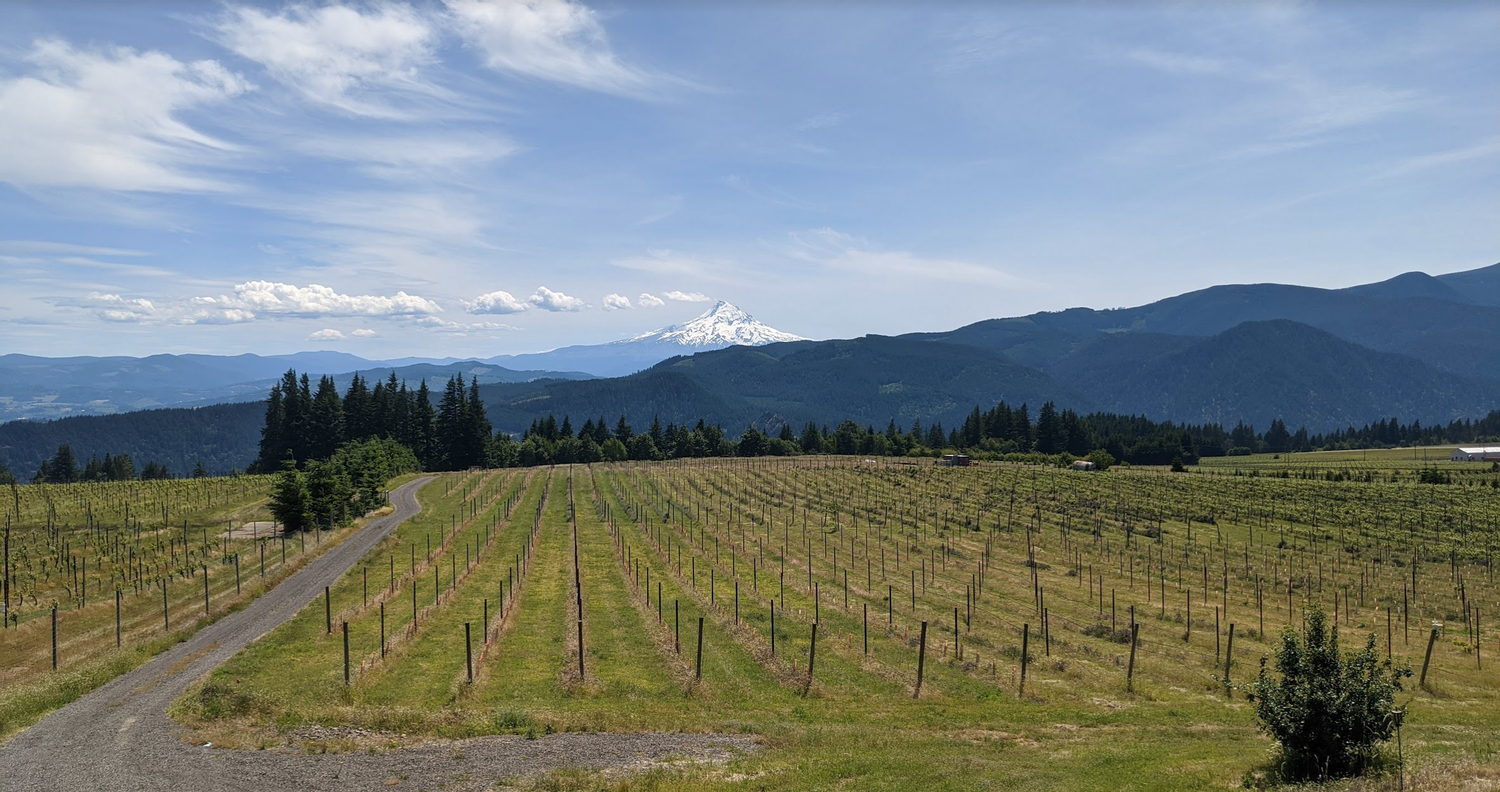
Another perk of regions that are relatively unknown is the “pioneer” or “wild wild west” element. Since there are still relatively few producers, there’s not one tried and true format that others are copying nor are there any mega beverage brands that owns multiple properties; winemakers are channeling their entrepreneurial spirit and doing things their way.
At Savage Grace, Michael Savage is creating wines that are bright, fruit forward with high acid. Nate Reddy at Hiyu Wine Farm is making natural wines, with organically farmed grapes. Alexis Pouillon at Domaine Pouillon is creating french-style wines as an homage to time he spent working in the Southern Rhone.
Diversity is not just in the grapes, but in the styles and passions of the different winemakers.
5. Major airport proximity
Visiting the Gorge is easy. For those near Seattle or Portland, the Gorge can be accessed via a car ride. For those further away, Portland (PDX) is a major international airport and is less than an hour drive to the Gorge. This makes assembling a group trip a breeze and is one reason why this area is becoming a very popular wedding destination.
6. Cooler than you
Many warm climate wine regions are in trouble. Both from the perspective of fire danger and also global warming, forcing the replanting of certain varietals. Bordeaux and Napa are both reporting that the rising temperatures will result in their famous Cabernet Sauvignon grapes being replanted with Malbec and Zinfandel respectively.
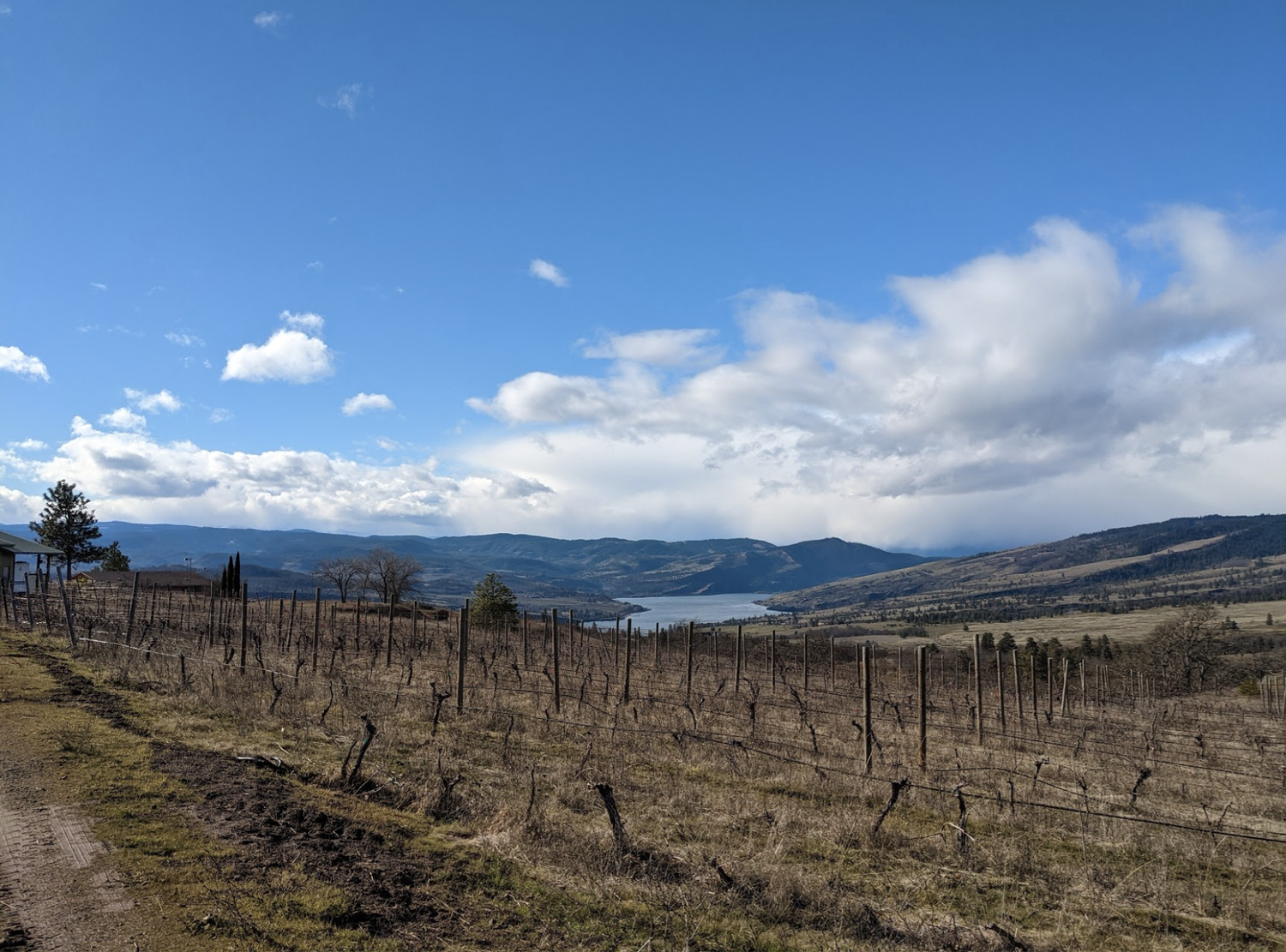
While parts of the Gorge do get warm and have some risk of fires, areas like White Salmon and Underwood are considered cool-climate (classified by temperature growing degree days). On top of this, the wind and river proximity brings a cooling presence over the vines in the Gorge.
Planting roots in the Gorge
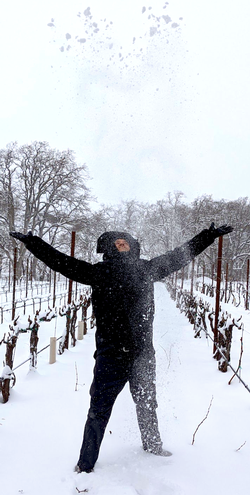
While traveling across the world's many wine regions, most often my favorites were ones that flew under the radar; those regions without national recognition but with massive potential. I would dream about one day running a small label in such a region, being somewhat of a pioneer to a region that would one day boom with tourism and superfans.
Three years ago, Cassie and I discovered the Columbia Gorge AVA by happenstance. We were blown away with the naturally beautiful terrain, the array of adventure activities and the budding wine scene. Ever since, we've used much of our vacation and remote flexibility to spend time here; we continue to grow more attached each day.
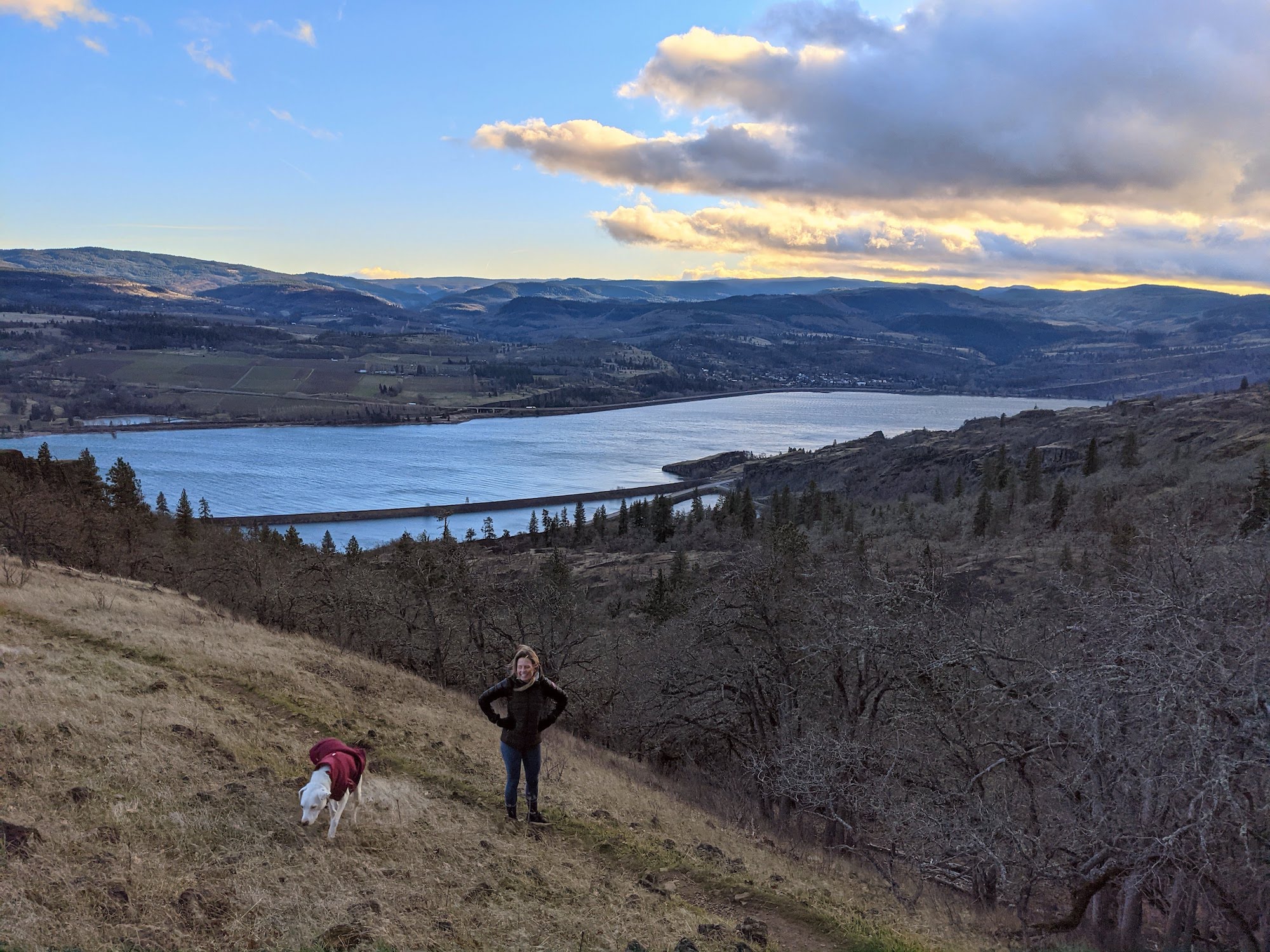
Dream of starting a winery
The goal of starting our own boutique wine brand remains our lifelong goal; perhaps a small winery facility and tasting room. But how does one attain this? We do have a fair amount of wine-related experience. Between us, we have:
Worked three harvests around the world
Hold certifications from WSET and Enology degree-in-progress at UC Davis
Visited & tasted in nearly every global wine region.
But even with this knowledge, there is still so much to learn about running and managing a wine label.
Learn by doing
Enter Domaine Pouillon: a boutique-sized winery in the Columbia Gorge producing ~2500 cases per annum, specializing in Rhone Varietals. It's a family-run operation complete with cool-climate estate Syrah vines and a small tasting room. The wines are fresh, bursting with aroma, acidity and depth--reminiscent of the types of wines we would find while traveling in Northern and Southern Rhone.
Domaine Pouillon is the type of winery that Cassie and I want to build down the road; it's the type of winery we seek out when we travel to new wine destinations. Locating the best small wineries around the world is the reason we started Wine Scribes. Thus, I've started working for Domaine Pouillon, channeling the motto of my alma mater: "Learn by doing".
First month on the job
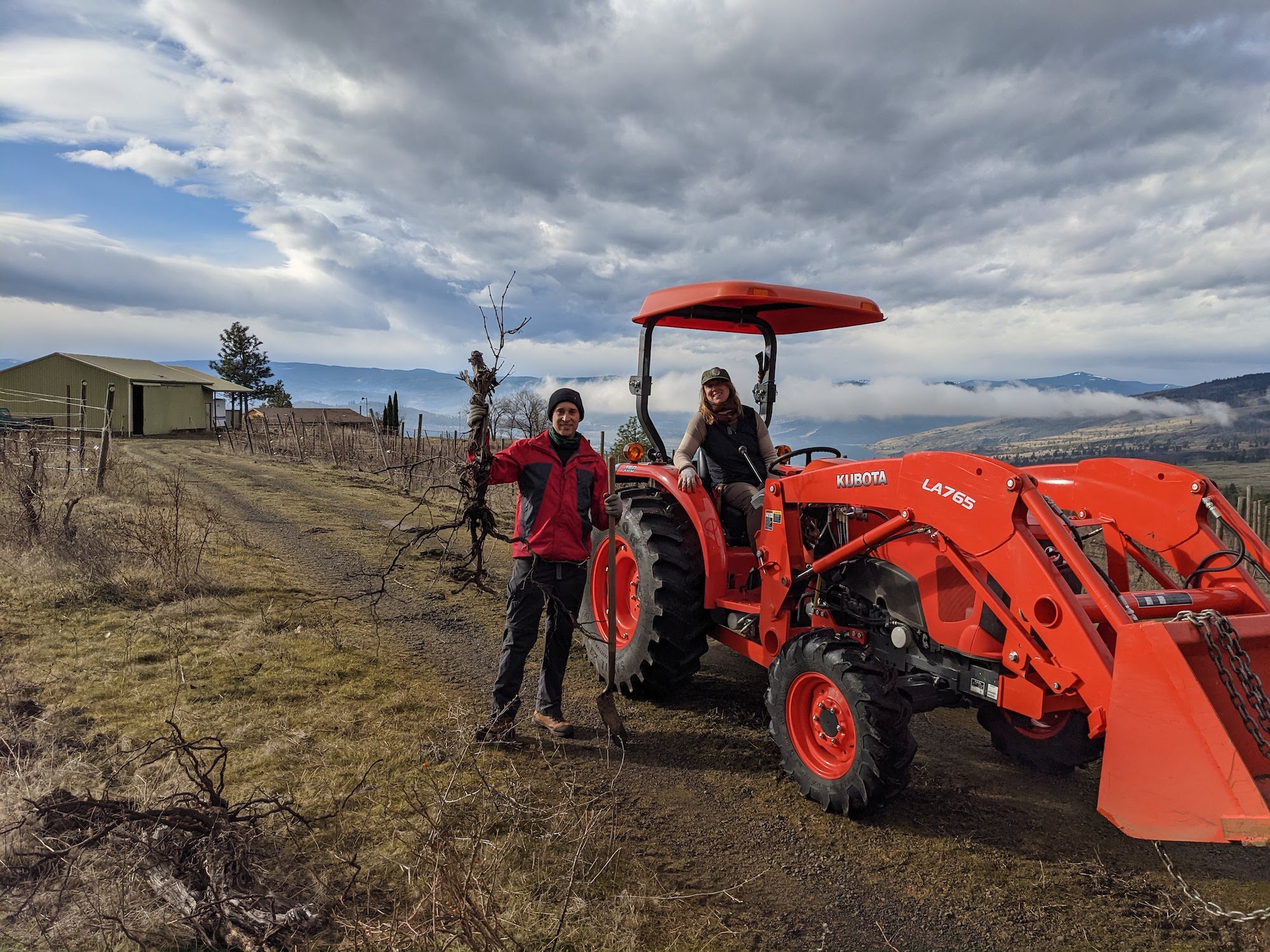
The first month has been a cacophony of cellar and vineyard tasks including barrel topping, sampling, tasting, racking, bottling, labeling, sanitizing, vine extractions, trellising and even roof repair. I'm drinking from the proverbial fire hose and loving each moment.
This is the benefit of working with small wineries--learn more, faster by being exposed to as many duties and responsibilities as possible. The experience so far has been priceless and am confident that it will serve as the building blocks of our dream.
stay in the know
Sign Up For Our Newsletter
Keep up to date on the latest wine releases, events, and promotions and get 10% off your next order.
